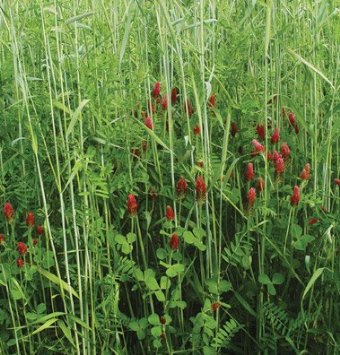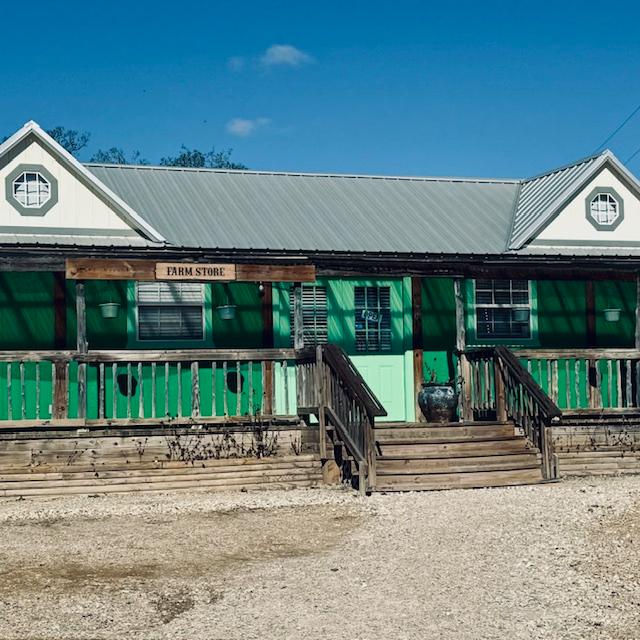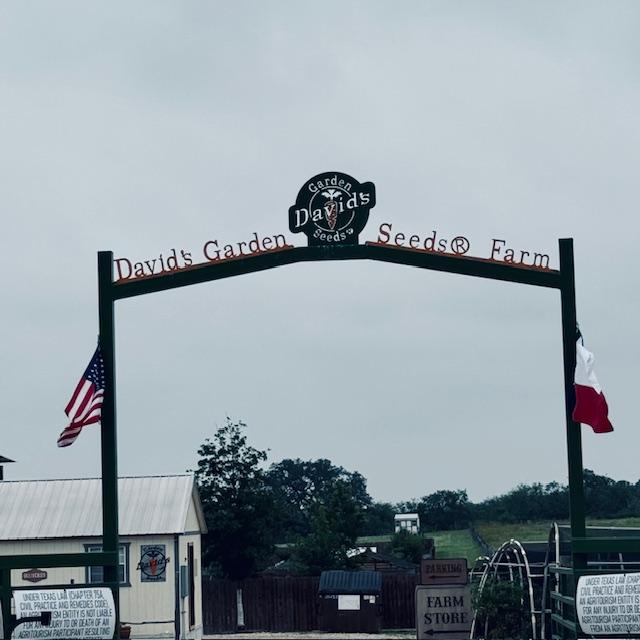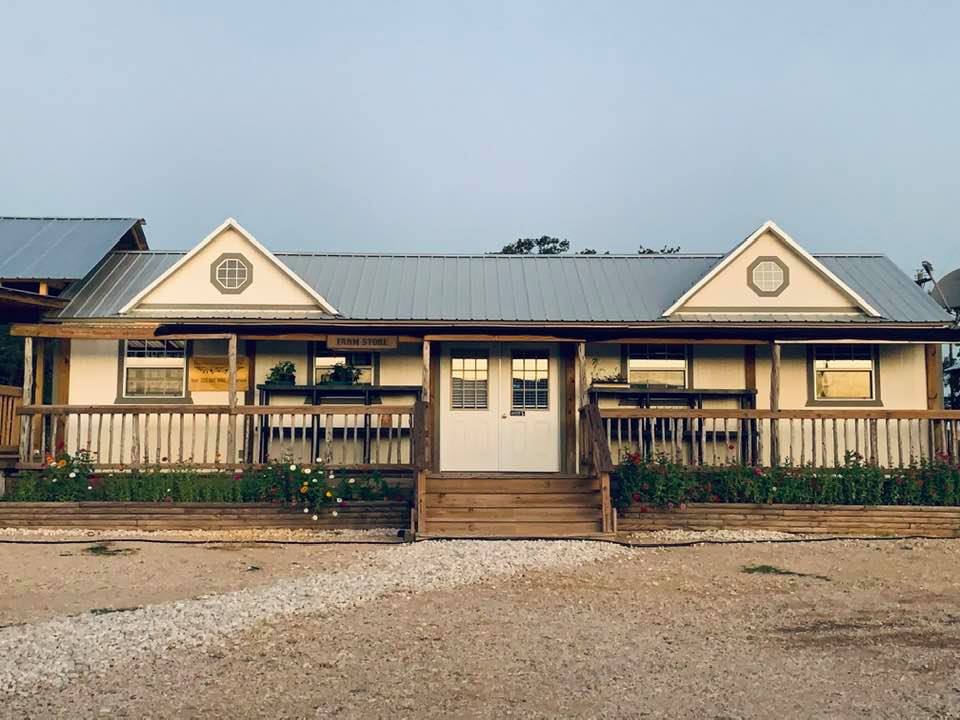Monthly Garden Chores For Warm Climates
This page is where you can find all of the monthly garden chores you will need to get done throughout the year, especially if you live in a warm climate like Texas, Florida, Arizona, and Southern California.
We garden year round here in South Central Texas. There is always something to grow here and there are always garden chores to be done.
 Carrots are growing, along with some weeds in the foreground. Our soil is all sand. We mix lots of compost in and use weed barrier which helps.
Carrots are growing, along with some weeds in the foreground. Our soil is all sand. We mix lots of compost in and use weed barrier which helps.I have been writing about what needs to be done every month in the garden for warm climates, like Texas. Of course, these chores will vary depending on where you live and the weather in your area.
You should keep your own notebook detailing the chores you find that need to be done in your garden by the month for your area. It will help you in years to come so you don't forget to do something important to help you grow the best garden you can. Remember, too, that gardening is an experiment. Some things that work in your area won't work in mine. Each year is different, bringing different temperatures and amounts of rain and sun, as well as pollinators, good and bad insects, and crop diseases. Don't expect to get the same results each year as far as your crops go. Each year will be different in some aspects.
If you live in Texas, the monthly garden chores listed below are mostly for you because that is where we live.
Monthly Garden Chores
 Asparagus ferns are on the left and strawberries are growing on the right. Asparagus puts out its stalks to eat in the spring and then ferns in the fall. Do not pull up the ferns.
Asparagus ferns are on the left and strawberries are growing on the right. Asparagus puts out its stalks to eat in the spring and then ferns in the fall. Do not pull up the ferns.If gardening is an enjoyable hobby for you, you will probably like getting down in the soil and working with it, adding compost, weeding, planting, and examining the plants for pests. If it is a way for you to grow food for your family, you will learn to like most parts of gardening because in the end, there is a good harvest to eat.
Make a game out of the monthly garden chores. Get the whole family involved. Teach your children and grandchildren how to garden. It is good for them to learn where food actually comes from, how seeds work, and how important it is not to throw chemicals on what we put in our bodies. How to grow food is a great life skill that you should teach your children. The schools won't teach them so it is up to us.
I hope this monthly breakdown helps you as you work in your garden throughout the year. Each month, write down what your garden chores are. If you need a good garden planner notebook, we have some for sale here that I have created.
Remember to have fun with your garden. Learn as you go and enjoy growing your own foods. There is something good that happens when we connect with the dirt and grow food we will eat. Don't be afraid to try planting new things that you have never eaten before. Grow your palate. Some new things you may end up loving. Other things you may not love and that is okay.
Plant lots of melons in the spring. Who doesn't love fresh cantaloupes, watermelons, and so many other melons? If you are brave and you enjoy a good gardening challenge, start some strawberries from seed, the most difficult seed we have to germinate. We recommend starting them in small pots indoors under grow lights until the seeds have germinated. Don't be surprised if it takes 30 days for a strawberry to come up. Most people give up after a week. Here are some germination tips written by David to help you start seeds indoors and out.
Having a garden is a lot of work but if you keep up with the monthly garden chores by making a list of what needs to be done each month, it will be a lot easier to keep up with and you will be rewarded with a lot of delicious foods.
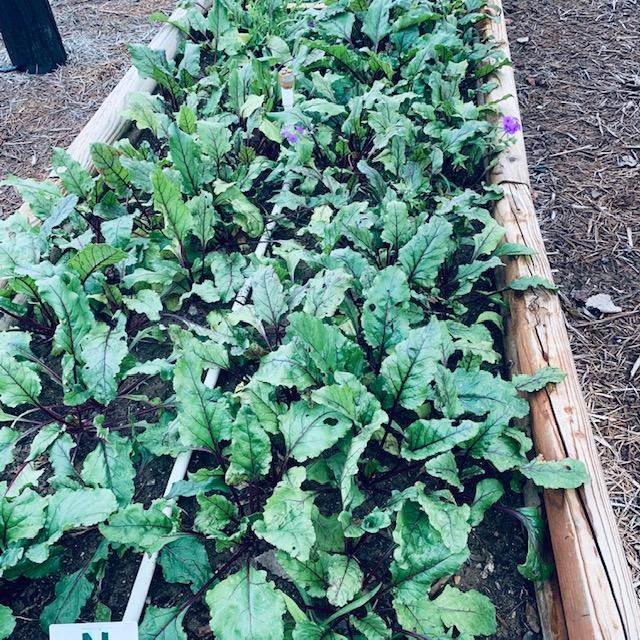 These beets are just about ready to pick. In fact, it will be included in our December chores, harvest your fall garden!
Then plant again.
These beets are just about ready to pick. In fact, it will be included in our December chores, harvest your fall garden!
Then plant again.Monthly Garden Chores
For Texas & Other Warm Climates
January - Monthly Garden Chores
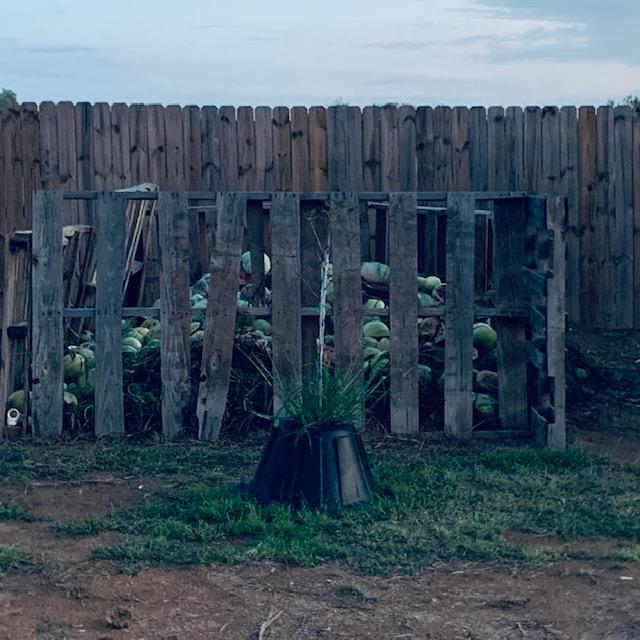 This is our compost bin. We add things along with some soil, in our case sand and stir. Keep adding yard clippings and kitchen waste along with soil to keep it going.
This is our compost bin. We add things along with some soil, in our case sand and stir. Keep adding yard clippings and kitchen waste along with soil to keep it going.If you have fruit trees, like we do, January garden chores should
include pruning them for better spring growth. There are books on how to
do this. This is also a great month to add cow manure to your trees for
fertilization.
Go through all of your garden tools in the shed and if you need to clean and/or sharpen them, do so now.
Dead head and prune rose bushes.
If
you live in a warm climate, plant asparagus seeds and artichoke seeds.
If you have previous asparagus ferns, chop them down to ground level.
They should be dead by now from frost. Do not pull them up or you won't
get new asparagus. Cut them down and clear the bed to make way for new
spring asparagus. Leave about one inch from the ground.
Add compost to your empty garden beds. Then put mulch on top.
Cut your cover crops down and then till them under, mixing them in with the soil in your garden area. You could also leave them on top acting as mulch. Either way, they will replenish your garden soil with nutrients.
Choose your spring seeds by visiting David's Garden Seeds® here.
Plan when and where you will plant each variety in your garden.
Early
in the month in Texas, start your tomato seeds indoors so they will be
ready when it is time for them to go into the ground in March. If you
don't start them by January, you probably won't get spring tomatoes.
Once the heat hits, tomatoes stop growing. I am talking about 95° plus
daytime temperatures and 75° plus nighttime temperatures which are too
hot to allow fruit to grow. To start them, be sure and have them under real grow lights. House lights or putting them in the window will not provide enough light.
In early January, plant
short day onions in the southern part of Texas, including the San
Antonio area. Of course, everyone's favorite onion in Texas in the spring is the Texas Early Grano yellow onion and we happen to carry the seeds. You can also start
flowers indoors in pots such as zinnias, gomphrenas, and sunflowers. Then, when it warms up, you can transplant them outside.
In the middle of January, you can plant potatoes in the ground or in pots outside.
This does not include sweet potatoes.
In late January in southern Texas, it is time to plant the beets, carrots, parsnips, radishes, and turnips in the ground for a second round. It is also time to plant snow peas, snap peas, and regular peas in the ground. Don't forget to sow the seeds for arugula, chard, lettuce, and other leafy greens like mache vit and spinach. Yes, they are cold hardy so give them a try.
One of the most important of January garden chores in Texas is to get all of your tomato seeds started in small pots in your greenhouse or in your home on grow mats which you will change to grow lights once they germinate. If Texans don't start their tomatoes in January, there won't be enough grow time before the sun gets too hot.
Special Note: If you get a very cold snap where the temperatures are below
freezing, some of the plants above may be damaged or dead. Texas does
not get a lot of freezing weather but in the past four to five years, we
have gotten enough cold weather anywhere from the beginning of December
through February that you may want to hold off on planting any of the
above until the end of February.
February - Monthly Garden Chores
- If you have rosebushes, prune them and deadhead them.
- Start your tomatoes in the greenhouse or indoors on heating mats if you have not done so in January.
- Start cantaloupes, cucumbers, kohlrabi, lettuce, pumpkins, watermelons, and zucchini in seed trays or starter pots indoors.
- Get your garden beds ready for spring planting. Add compost and till it into the soil.
- Do a complete clean out of your chicken house and other animal houses.
- Stir your compost piles.
As stated above, February monthly garden chores for Texas include stirring your compost pile and deep cleaning your chicken coop if you have one. Get all of the chicken poo over to the compost pile with dirt so the poo can compost. Chicken manure should always be composted before putting it in with your garden soil. If it is not composted, it will burn your plants.
If you have rabbits, mix their poo directly in your garden
without being composted. Your garden plants will love rabbit manure.
If you have farm animals, collect the manure and compost it for your garden as one of your February garden chores.
 This is the 4 tier plan for the above mentioned raised garden bed. Make this as one of your February garden chores.
This is the 4 tier plan for the above mentioned raised garden bed. Make this as one of your February garden chores.if there is no snow on the ground where you are, you should plan and build some raised garden beds. They can be as simple as a rectangle on the ground using planks of wood to hold the dirt or as fancy as you want to make them. David once made a four tiered garden bed with the lowest one to the ground as the biggest. Each additional layer was smaller. We filled it with strawberries and it did very well for several years in our yard in San Antonio. Building it will be one of the good February garden chores your perform.
March - Monthly Garden Chores
March monthly garden chores include pulling up any dead plants and roots, cleaning up plant debris left behind from last fall, and testing the soil pH.
Once the danger of frost is past, begin to transplant your seedlings outside. Make sure that you harden them off first!
Prepare and build more garden beds if that is what you were planning to do.
Buy new baby chicks if you will be adding to your flock.
March monthly garden chores can include stirring compost into your raised beds. Weed garden beds first and then add the compost. Some gardeners add worms into their beds.
Weed the flower beds. Add compost. Plant, water, and then mulch.
Take care of the plants in your greenhouse if you have one. Some may need to be replanted while others need to be divided and put in other pots.
April - Monthly Garden Chores
There are always April garden chores to complete, but the biggest of the April garden chores is to get all of your seeds and seedlings in the ground now that the danger of frost is past here in Texas. I realize that up north you can still get snow in the middle of April so I think you need to wait a bit longer. Check your Almanac for that or check with your local county extension agent or just Google it.
Here are a few more chores:
Plant your seeds outside for roots, greens, and lettuce.
Plant your transplants if you have not done so already, but don't forget to harden off the plants.
Mulch your garlic bed that you planted last fall.
Plant potatoes and sweet potatoes.
Start winter and summer squash, melons, beans, and basil.
Today's April garden chores include remembering to water the plants you have plus the seeds you planted. Without water, nothing will happen. Where we are, there is no rain, so there are no vegetables or flowers without watering this year.
Our April monthly garden chores for today include adding compost to any garden bed areas that have not been composted. Then add mulch on top once the beds have been planted.
Your April garden chores also include planting any starts you have in your greenhouse, if it is warm enough in your area now.
Your April garden chores for today include inspecting your growing
plants, especially tomatoes and squash for bugs. When you see the tomato
hornworm or those nasty squash bugs, smush them immediately. Look on
the underside of the leaves to make sure there are no insect eggs laid
on them. Remove the eggs if you find any and destroy them.
April garden chores include planting flowers or flower seeds among your vegetable plants. This encourages bees and other pollinators to visit your garden and pollinate your plants. Marigolds and Nasturtium keep undesirable insects off of your vegetable plants. Wild Bergamot, chives, oregano, and mint, which are herbs, are loved by bees, as well as sunflowers, bee balm, daisies, and dahlias.
April garden chores today include (if you have not yet planted them), direct sowing the following into your garden beds:
- melons and watermelon
- squash, both summer and winter
- all beans
- corn
- cucumbers
- Swiss chard
- greens,
- Southern peas
- okra
May - Monthly Garden Chores
Today's May garden chores include watering, watering, and watering. As the temperature heats up, your garden will need more and more water unless you live in an amazing cool, Northern place. Down here in South Central Texas, it is freaking hot, often hitting in the 100s this month and it is humid. The heat just dries everything out. All of a sudden, your plants look all withered when a little while ago, they were fine. Make sure you water them. Do not deprive them.
Some more May garden chores:
Plant your squashes, pumpkins, and melons, if you have not already done so.
Sow more greens. You can never have enough greens, especially if you have chickens because they love them, too.
- Every few weeks, you will need to put a small amount of nitrogen fertilizer on your tomato plants and pepper plants once they begin making fruit.
- Check all of your plants for aphids. If you find some, power hose them off and spray your plants with Safer Soap or Hot Pepper Wax to protect them.
- Keep watch for powdery mildew on your plants. Use a fungicide if you need to.
- Replant seeds where nothing came up.
- Add a nice layer of mulch to your garden beds to keep moisture in the ground.
- Plant some pretty and colorful flowers to enjoy.
- Plant a good variety of herbs such as catnip, basil, lemon balm, rosemary, mints, thyme and oregano.
- May garden chores today should include carefully looking around
plants for snakes before putting your hands into the garden. I have seen
two live snakes this week out in the yard. I am a bit freaked out by
it. Wear gloves and boots to work out in the yard if you are in Texas because you don't know what is out there.
June - Monthly Garden Chores
Every month has monthly garden chores and the hot month of June is no exception.
Weed and water daily.
Keep looking for plant pests and smash them.
Get stuff ready for fall planting in September including getting your beds ready.
Order your fall seeds now.
Harvest your garlic if you planted it last September.
Today's June garden chores include harvesting whatever is still alive out in the 100° plus heat that you have not pulled up yet. In normal parts of the country, just weed and water with some fertilizer once a month. David prefers Medina fertilizers and liquid fish emulsion.
As I mentioned earlier, today's June garden chores include harvesting
and pulling up plants that are finished growing.
Again,
watering is vital for any plants that are still growing and producing. I
cannot say it enough. Do not wait for it to rain. Water your plants.
June garden chores include deadheading the zinnias, roses and other perennial flowers you may have in your yard.
July - Monthly Garden Chores
The most important of all July garden chores here in South Central Texas is to water, water, water. If some things go one or two days with no water, they are dead in this horrible heat.
Pull up dead and dying plants.
Add compost for fall beds if you live in a warm place where you will have a fall garden, like Texas.
July garden chores are important. Another one of the really important July garden chores is to harvest, harvest, harvest. Things are ripening rapidly and need to be picked before they get too big and before animals or bugs get the fruit and eat it or bite it.
One of David's favorite July garden chores is pulling out the old,
dead, and/or no-longer-producing plants and preparing the ground for the
next planting in late August and early September. This is South Central Texas and it gets too
hot here for things to grow this time of year.
If you have dogs in your yard, part of your monthly chores and part of July garden chores is to pick up the dog poo from your yard at least once a week. Some people don't. If you have livestock, you should be cleaning up their poo and such at least once a week. Some do it daily and that helps cut back on the stench and the flies in the extreme heat.
Use an organic fly spray outdoors near your animals. We get ours from our pest control guy. It says it is safe for animals.
Harvest your garlic now if you planted it last October.
July garden chores in this heat are no fun to do. Just
feeding and watering the animals this morning was horrible because of
the humidity and heat.
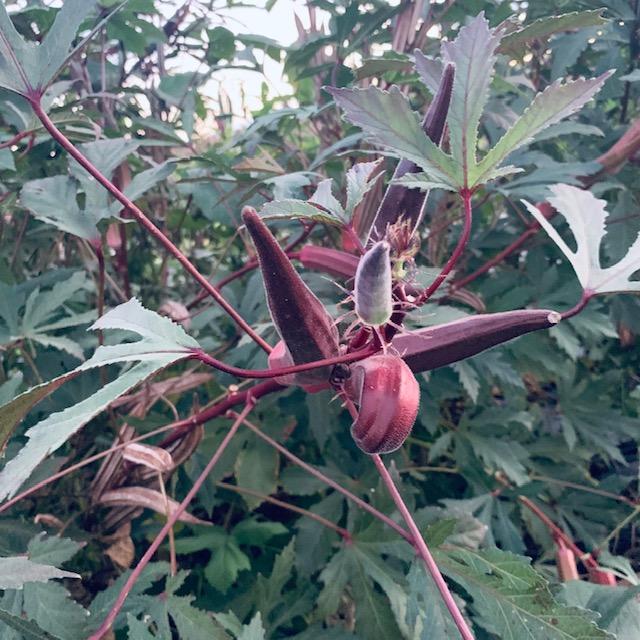 This is red burgundy okra growing in our garden. For okra, the hotter the temperature, the better it does.
This is red burgundy okra growing in our garden. For okra, the hotter the temperature, the better it does.August - Monthly Garden Chores
August garden chores begin with pulling up anything left from spring that you did not already pull up, unless that plant is still producing. For instance, our eggplants and watermelon plants are still producing a lot so we will not be pulling them up just yet.
 The ground cherries are done producing and have turned brown. Time to harvest the cherries inside the little brown pods.
The ground cherries are done producing and have turned brown. Time to harvest the cherries inside the little brown pods.Our ground cherry plants, grown with seeds from David's Garden Seeds®, were green just two weeks ago, putting out a lot of cherries. They are now brown with tons of ground cherries produced. I am cutting them down today to harvest the ground cherries. They are dead but the cherries are still good.
Our highlighted August garden chores for today are to add homemade compost to your now empty raised garden beds to prepare them for the fall seeds that you will be planting in just 2.5 weeks and mix it into the soil. You can just use a shovel or a hoe. You do not need to till up the soil. If you need some fall seed ideas, check out our Texas Fall Seed Set over at David's Garden Seeds® here.
Of course, if you are not finished planting for fall by August 31, you can continue to plant through September 3. Now keep in mind that this is for hot places like Texas, the deep south and the southwest. It most likely will not cool down much until October and November when you should get some good harvests. But the last few years have been weird weather wise. For instance, we have had early November and December frosts and snow and ice, something we almost never had in the 25 years we have lived in the San Antonio area.
Today's August garden chores are to plan your fall garden planting
situation. Decide what you will plant and where you will plant each
item. Put it all on paper on purpose so when that final week of August
comes, things will go smoothly as you plant your fall garden.
Plant lots of fall flowers. If we have a
mild winter this year, the flowers could last through the winter and
into spring.
Do some more canning, dehydrating, and/or freeze drying, as well.
 We can food for our own benefit. It costs way too much to sell canned items. We learned to can when we lived in Colorado Springs. Our garden there was amazing.
We can food for our own benefit. It costs way too much to sell canned items. We learned to can when we lived in Colorado Springs. Our garden there was amazing.September - Monthly Garden Chores
You
should be planting seeds and plants and watering now for your fall garden because now is the time.
Prepare a place for your garlic bulbs and plant them. Then water and mulch
them. Garlic takes eight months to grow. If you plant in September, then you will harvest your garlic in June.
Concentrate on dead heading all of the dead blooms off of
flower bushes, like rosebushes, hibiscus, and so many more plants for
your monthly garden chores in September. This will promote good spring blooms.
Let zinnias and other annuals drop their seeds so they re-seed for next spring. Do not dead head these flowers and they will come back in the spring.
Keep up with your weeding in the garden beds around your property. If you do, there will be that much less work for you to do in the spring. Pull up any dead plants that you have not yet cleaned up from summer.
Plant cover crops so you can add nutrients to the soil.
September garden chores will include putting down a fresh layer of
mulch over the beds you are not using this fall so they are ready for
spring. Mulch the beds where you have planted fall garden seeds as well
to keep moisture in.
Make sure that you have picked everything that is growing from summer. Cook up any produce and save some for later by
storing, freezing, drying, canning, or pickling if you can.
Now,
continue to weed and water as I mentioned above. Pay attention to the
new plants and look for caterpillars and bugs. You will want to kill
them and spray your plants with Safer Soap, an organic spray that bugs
hate.
October - Monthly Garden Chores
October is a significant month for Texas monthly garden chores.
Plant your wildflower seeds. Wildflower seeds including bluebonnets must be cold stratified in order to bloom in early spring.
Plant bush and pole beans. You will get your best beans in the fall.
Plant your Texas 1015Y onion seeds. They take 110 days. This is the
best yellow onion around. We plant a second round in late December each
year.
Plant your garlic bulbs if you have not yet done so.
Remember that garlic takes a full eight months to grow. If you plant
them in October, you will not harvest garlic until July.
Continue harvesting fruits off of plants that are still putting out fruit from this past summer.
Weed and water your garden.
Deadhead roses and other flowers.
Plant cool weather flowers like snapdragons, violas, pansies, and petunias.
Trim dead leaves and vines off of your plants. It is common for some leafy plants to let leaves die and then grow new ones. The brown, dead leaves don't look very pretty so I cut them off.
November - Monthly Garden Chores
The first of your monthly garden chores for November, no matter where you live, is to rake up all of the leaves that are on the ground. Here in Texas, our leaves come down after Christmas, usually at the beginning of January, but I realize that for most of the country this is not true. So rake everything into a big pile and get it over to your compost area. Yes, you need to compost these leaves so they are ready to be added to your garden beds in the spring.
Pull up all of the leftover dead plants that you grew this
year.
If
the plant debris you have pulled up is free of bugs, compost it. If
there are bugs or the plant was destroyed by garden pests, throw it
away.
One of the November garden chores I have not yet mentioned is to
plant a cover crop in warmer climates. David's Garden Seeds® has a nice
selection of cover crops. These will put nutrients back into the soil
that your garden plants may have used up.
An important part of monthly garden chores for November is to plan your spring garden now. Remember where things were planted and change it up. You need to rotate your crops so the soil is not depleted of nutrients. Draw it up on paper from this season and draw next season's plants, moving things around so you can decide what you want to plant and how many seeds you will need to order for spring.
Actually order your garden seeds now while
we have an excellent selection. The past several springs were very busy due
to coronavirus and we ran out of a lot of seed varieties. Right now, we
have most of your favorites in. Don't wait until spring because most
other gardeners are getting their seeds now. Many people give seeds as
Christmas gifts which is when our seeds really start flying off of the
shelves for spring.
Continue to add to your compost pile and be sure to stir your compost pile. If you have not yet added mulch to your garden beds for next spring, add it now. Get it all mixed in with the soil. Come spring, you will be glad you do not have to do that task again. As for the newer mulch pile that you continue to make, as long as you are able, stir it up a few times a week as you add scraps to it. Let it sit over winter and when you decide to add some new garden bed areas in the spring to your ever growing garden, you will have fresh compost to enrich your soil. Our compost pile just keeps going year round.
If you need soil for spring, don't
put it off. Go to your local soil provider and make this one of your
November garden chores. Have a truckload delivered and fill your beds for spring planting.
If you have an asparagus patch, do not pull those up. Once the
ferns are dead (after the first fall frost), cut them down, leaving about an inch above the ground.
If you treat your asparagus patch well, it can last up to 20 years. If you do
not have an asparagus patch, plant one now in warmer climates. Remember
you will not harvest anything for the entire first year so now is a good
time to plant and establish your asparagus.
Notice all of the seeds on
the ferns. Collect the seeds if you save them. Compost the ferns and
now your bed is ready for winter.
I have been reading about asparagus on some other sites and they say that you cannot harvest asparagus for three to seven years after planting seeds. It may matter depending on where you live but here in Texas, I planted our asparagus in March of 2020 and we harvested our first asparagus in April of 2021. We had fresh asparagus every single day since then until the awful heat of summer when the ferns started growing and the tender shoots no longer did. This is normal for asparagus. If you think you want some more asparagus, add this to your November garden chores. This is the time to plant it.
December - Monthly Garden Chores
Before the brunt of winter gets here, one of the first December garden chores you should accomplish is to mulch your garden beds, especially if you have root crops or garlic growing in them. Here in Texas, we have things growing year round. It is good to put a nice layer of mulch or hay on top of the garlic, carrots, beets, radishes, turnips, onions, strawberries (yes, strawberries--we are in the Strawberry Capital of Texas where they grow in the winter!), and whatever other winter crops you may be growing underground. Giving them a little extra insulation from freezing temperatures, ice, and snow is a smart thing to do.
Water, water, water! We don't get much rain in December but we have to keep the plants alive.
If you have been in a drought and you are still not getting
sufficient rains, you will need to keep on watering the plants you are
growing in your garden. Don't forget that.
Plan for your spring garden now and order your seeds if you are smart.
This next one is not really considered a task but if you live in a warmer area and you are growing plants during the cooler months, this should be one of your December garden chores. What is it? Buy and have garden row covers ready in case you get a freeze in your area. Here, it is pretty warm throughout the winter months but for the past two years, we have had actual freezes and snow and ice. We protected some things with row covers and at the end of the week when it warmed back up, we removed the covers and most things were just fine.
Do you have an asparagus patch? If so, one of the December garden chores you need to perform involves asparagus. We have a lot of asparagus growing out in our garden. If you take good care of your asparagus patch, it will last between 15 and 20 years. Did you know that? In the hot summer, when the asparagus that you eat stops coming up, you get these fern like shoots. Do not cut them down until after the first fall frost. After that first frost, you want to cut them off to about one inch above the ground. Then add a layer of mulch or hay on top of them to protect the asparagus roots for spring. I mention hay a lot because we are out in the country now and hay is used for a lot of things out here.
If you have farm animals, it is time to winterize
their pens. You will need to put up plastic sheeting around the open
walls to keep the wind out as it turns cold. If you live in a colder
climate, you probably did this in October or November, but here in
Texas, it is turning cold now and the temperatures will be frigid by the
end of the week, in the 20s and even into the teens. The chickens,
rabbits, and goats need to be kept out of the icy wind and they need
to stay dry if it rains. Lots of ventilation in our summer months is
very important but we have to protect them in winter. They will still go out to play in their yards but keeping them dry on wet days and keeping them warm on cold nights is so important. Also, check throughout the day to make sure their water is not frozen solid. They must have fresh water at all times that they can drink.
Another one of the December garden chores if you live in a warm place is to stop fertilizing your plants for now. Why? Because if you get a cold snap, the new growth on your plants will become damaged if you are fertilizing. So give the fertilizer a winter rest. Spring will be here before you know it and then you can start using it again.
Speaking
of monthly garden chores, several of the people who came into the farm
store today bought some fall/winter seeds that they can plant right now
in December and overwinter like carrots, onions, garlic, turnips, and beets. In Texas and
other warm places, plant root crops now while it is still warm and grow
them throughout the winter. They will be fine in mild weather. Even
through the last two years of freezing and snow, ours were fine.
Your monthly garden chores for December should include harvesting what you have
growing right now. If you are growing root crops that you planted back in
September, check to see if they are ready to be harvested by pulling one
up. If they are ready, harvest them and then replant before the ground freezes.
Then you can harvest again in late February or early March, depending on
what you plant.
The final monthly garden chore for December is simple. Add compost to all of your garden beds or garden areas where you will plant in the spring. Mixing it into the soil, along with fall leaves will be good for the soil, providing it with much needed nutrients for the spring seeds.
Return from Monthly Garden Chores to Garden Ideas
Anything To Share On This Topic?
Would you like to share additional information about this topic with all of us?
Since 2009, over 1,500,000 home gardeners, all across the USA, have relied on David's Garden Seeds® to grow beautiful gardens. Trust is at the heart of it. Our customers know David's Garden Seeds® stocks only the highest quality seeds available. Our mission is to become your lifetime supplier of quality seeds. It isn't just to serve you once; we want to earn your trust as your primary supplier.
Watch Our 2022 TV Commercial!
Sing Along To Our Jingle
♪♫♪♪ ♫ ♪ ♫♪♫♫
♪♫♪♪♫♫
Peppers and peas
And lots of yummy greens
You can't go wrong
With Squash This Long
At David's Garden Seeds
♪ ♫ ♪ ♫
Our New 2024 TV Ad
Please like and subscribe on YouTube and come visit us at our Farm Store! The music on our TV ad was written, played, and sung by our son, Matthew Schulze. You can meet him when you come to the farm. He just might give you a tour. Ask him to grab a guitar and sing our jingle that he wrote.

We are David's Garden Seeds®. If you need great seeds, we've got over 1,200 varieties to choose from.
Subscribe To Mrs. David's Garden Seeds® Newsletter For FREE!
Find out what is going on down on the farm by reading our blog and by subscribing to our free newsletter for all of the information going down at David's Garden Seeds® and on the farm. I love to share helpful information with you. Please let your friends know and y'all come on down for a visit when you get the chance. We would love to meet you!
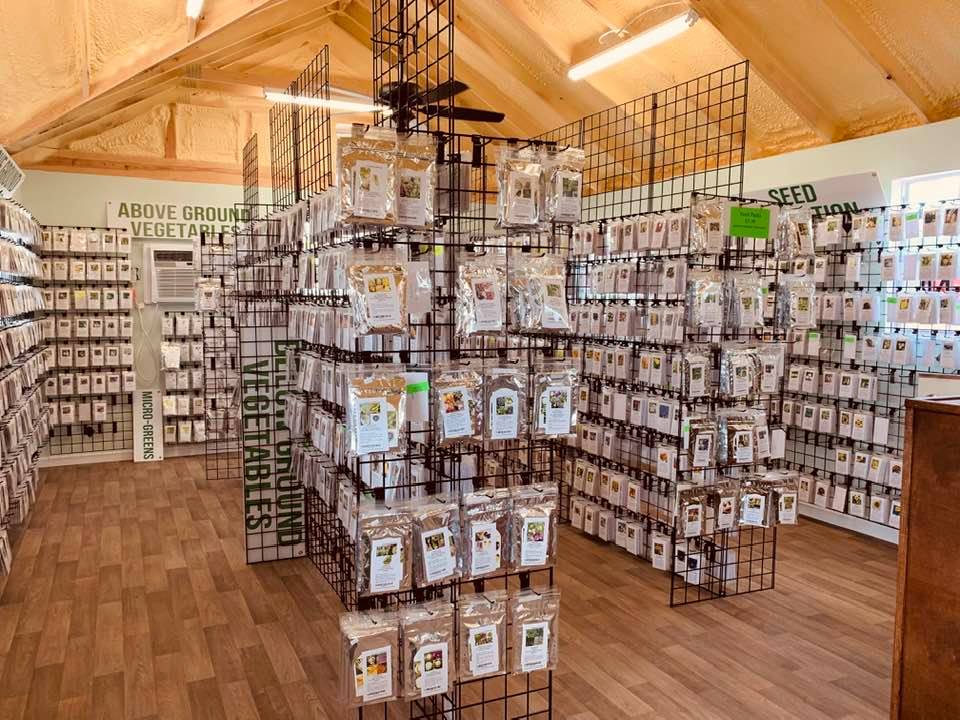
 Our bee hives
Our bee hives Our fish pond
Our fish pond Our chickens
Our chickens Our bunny rabbits
Our bunny rabbits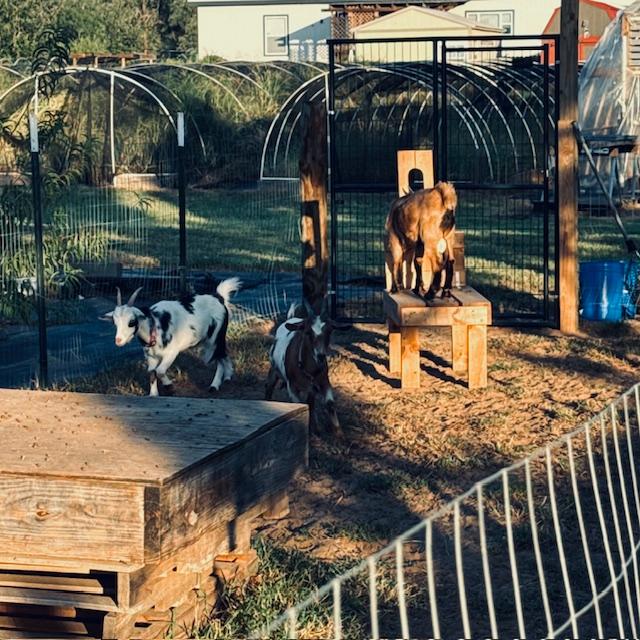 Our Nigerian Dwarf goats
Our Nigerian Dwarf goats A few of our raised garden beds
A few of our raised garden beds Our orchard and hoop houses
Our orchard and hoop houses Inside our high tunnel
Inside our high tunnel Take a selfie at our official selfie spot!
Take a selfie at our official selfie spot! Flowers, bees, and butterflies are everywhere!
Flowers, bees, and butterflies are everywhere!








